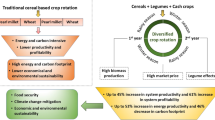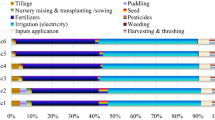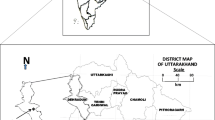Abstract
Two of the most pressing sustainability issues are the depletion of fossil energy resources and the emission of atmospheric green house gases like carbon dioxide to the atmosphere. The aim of this study was to assess energy budgeting and carbon footprint in transgenic cotton–wheat cropping system through peanut intercropping with using 25–50 % substitution of recommended dose of nitrogen (RDN) of cotton through farmyard manure (FYM) along with 100 % RDN through urea and control (0 N). To quantify the residual effects of previous crops and their fertility levels, a succeeding crop of wheat was grown with varying rates of nitrogen, viz. 0, 50, 100, and 150 kg ha−1. Cotton + peanut–wheat cropping system recorded 21 % higher system productivity which ultimately helped to maintain higher net energy return (22 %), energy use efficiency (12 %), human energy profitability (3 %), energy productivity (7 %), carbon outputs (20 %), carbon efficiency (17 %), and 11 % lower carbon footprint over sole cotton–wheat cropping system. Peanut addition in cotton–wheat system increased the share of renewable energy inputs from 18 to 21 %. With substitution of 25 % RDN of cotton through FYM, share of renewable energy resources increased in the range of 21 % which resulted into higher system productivity (4 %), net energy return (5 %), energy ratio (6 %), human energy profitability (74 %), energy productivity (6 %), energy profitability (5 %), and 5 % lower carbon footprint over no substitution. The highest carbon footprint (0.201) was recorded under control followed by 50 % substitution of RDN through FYM (0.189). With each successive increase in N dose up to 150 kg N ha−1 to wheat, energy productivity significantly reduced and share of renewable energy inputs decreased from 25 to 13 %. Application of 100 kg N ha−1 to wheat maintained the highest grain yield (3.71 t ha−1), net energy return (105,516 MJ ha−1), and human energy profitability (223.4) over other N doses applied to wheat. Application of 50 kg N ha−1 to wheat maintained the least carbon footprint (0.091) followed by 100 kg N ha−1 (0.100). Our study indicates that system productivity as well as energy and carbon use efficiencies of transgenic cotton–wheat production system can be enhanced by inclusion of peanut as an intercrop in cotton and substitution of 25 % RDN of cotton through FYM, as well as application of 100 kg N ha−1 to succeeding wheat crop.



Similar content being viewed by others
References
Alam, M. S., Alam, M. R., & Islam, K. K. (2005). Energy flow in agriculture: Bangladesh. American Journal of Environmental Sciences, 1(3), 213–220.
Blaise, D., Bonde, A. N., & Chaudhary, R. S. (2005). Nutrient uptake and balance of cotton + pigeonpea strip intercropping on rainfed vertisols of central India. Nutrient Cycling in Agroecosystem, 73(2–3), 135–145.
Chen, Z. Y., Chen, J. S., & Fei, Y. H. (2006). Estimate of groundwater renewable rate by tritium in the piedmont plain of the Taihang mountains. Nuclear Techniques, 29(6), 426–431 (in Chinese).
Cochran, W. G., & Cox, G. M. (1957). Experimental designs (2nd ed.). Wiley: New York.
Devasenapathy, P., Senthilkumar, G., & Shanmugam, P. M. (2009). Energy management in crop production. Indian Journal of Agronomy, 54(1), 80–90.
Esengun, K., Erdal, G., Gunduz, O., & Erdal, H. (2007). An economic analysis and energy use in stake-tomato production in Tokat province of Turkey. Renewable Energy, 32, 1873–1881.
Ghorbani, R., Mondani, F., Amirmoradi, S., Feizi, H., Khorramdel, S., Teimouri, M., Sanjani, S., Anvarkhah, S., & Aghel, H. (2011). A case study of energy use and economical analysis of irrigated and dryland wheat production systems. Applied Energy, 88, 283–288.
Heidari, M. D., & Omid, M. (2011). Energy use patterns and econometric models of major greenhouse vegetable productions in Iran. Energy, 36, 220–225.
I.C.A.R. (2010). Agricultural research data book. New Delhi: Indian Council of Agricultural Research.
Ittersum, M. K., van Ewert, F., Heckelei, T., Wery, J., Olsson, J. A., Andersen, E., Bezlepkina, I., Brouwer, F. M., Donatelli, M., Flichman, G., Olsson, L., Rizzoli, A. E., van der Wal, T., Wien, J. E., & Wolf, J. (2008). Integrated assessment of agricultural systems—a component-based framework for the European Union (SEAMLESS). Agricultural System, 96, 1–3.
James, C. (2013). Global Status of Commercialized Biotech/GM Crops: ISAAA Brief No. 46. Ithaca: ISAAA.
Karlen, D. L., Kramer, L. A., & Logsdon, S. D. (1998). Field-scale nitrogen balance associated with long-term continuous corn production. Agronomy Journal, 90, 644–650.
Khan, M. A., Awan, I. U., & Zafar, J. (2009). Energy requirement and economic analysis of rice production in western part of Pakistan. Soil Environment, 28(1), 60–67.
Lal, R. (2004). Carbon emission from farm operations. Environmental International, 30, 981–990.
Lupwayi, N. Z., & Kennedy, A. C. (2007). Grain legumes in northern plains: impacts on selected biological processes. Agronomy Journal, 99, 1700–1719. doi:10.2134/agronj2006.0313s.
Ma, B. L., Liang, B. C., Biswas, D. K., Morrison, M. J., & McLaughlin, N. B. (2012). The carbon footprint of maize production as affected by nitrogen fertilizer and maize–legume rotations. Nutrient Cycling in Agroecosystem, 94, 15–31.
Mandal, K. G., Saha, K. P., Ghosh, P. K., Hati, K. M., & Bandyopadhyay, K. K. (2002). Bioenergy and economic analysis of soybean-based crop production systems in central India. Biomass and Bioenergy, 23, 337–345.
Monteny, G. J., Bannink, A., & Chadwick, D. (2006). Greenhouse gas abatement strategies for animal husbandry. Agricultural Ecosystem and Environment, 112, 163–170.
O.E.P.P. (2000). Thailand’s Initial National Communication under the UNFCCC (Exclusive Summary). Thailand: Office of Environmental Policy and Planning, Ministry of Science, Technology and Environment.
Pimentel, D. (1980). Energy inputs for the production, formulation, packaging, and transport of various pesticides. In D. Pimentel (Ed.), Handbook of energy utilization in agriculture (pp. 45–55). Boca Raton: CRC Press.
Singh, R. J., & Ahlawat, I. P. S. (2012). Dry matter, nitrogen, phosphorous, and potassium partitioning, accumulation and use efficiency in transgenic cotton based cropping systems. Communication in Soil Science and Plant Analysis, 43(20), 2633–2650. doi:10.1080/00103624.2012.716125.
Singh, R. J., & Ahlawat, I. P. S. (2014a). Growth behaviour of transgenic cotton with peanut intercropping system using modified fertilization technique. Proceedings of the National Academy of Sciences, India Section B: Biological Sciences, 84(1), 19–30. doi:10.1007/s40011-013-0200-z.
Singh, R. J., & Ahlawat, I. P. S. (2014b). Effects of transgenic cotton-based cropping systems and their fertility levels on succeeding wheat crop. Communication in Soil Science and Plant Analysis, 45(18), 2385–2396. doi:10.1080/00103624.2014.912291.
Singh, M. K., Pal, S. K., Thakur, R., & Verma, U. N. (1997). Energy input–output relationship of cropping systems. Indian Journal of Agricultural Sciences, 67(6), 262–264.
Singh, K. P., Prakash, V., Srinivas, K., & Srivastva, A. K. (2008). Effect of tillage management on energy-use efficiency and economics of soybean (Glycine max) based cropping systems under the rainfed conditions in north-west Himalayan region. Soil and Tillage Research, 100, 78–82.
Singh, R. J., Ahlawat, I. P. S., & Gangaiah, B. (2009). Direct and residual effects of nitrogen requirement in Bt cotton–wheat cropping system. Indian Journal of Agronomy, 54(4), 401–408.
Singh, R. J., Ahlawat, I. P. S., & Kumar, K. (2013). Productivity and profitability of the transgenic cotton–wheat production system through peanut intercropping and FYM addition. Experimental Agriculture, 49(3), 321–335. doi:10.1017/S0014479713000197.
Stout, B. A. (1990). Handbook of energy for world agriculture. London: Elsevier Applied Science.
Subba Rao, G. V., Kumar Rao, J. V. D. K., Kumar, J., Johansen, C., Deb, U. K., & Ahmed, I. (2001). Spatial distribution and quantification of rice fallow in South Asia—potential for legumes (p. 315). UK: ICRISAT, Hyderabad; NRSA, Hyderabad and DFID.
Subbaiah, H., Nanjappa, H. V., & Ramachandrappa, B. K. (1997). Nutrient uptake by crop and weed as influenced by intercropping systems in groundnut. Indian Journal of Agronomy, 42, 59–62.
Uhlin, H. (1998). Why energy productivity is increasing: an I–O analysis of Swedish agriculture. Agricultural System, 56(4), 443–465.
van Groenigen, J. W., Velthof, G. L., Oenema, O., Van Groenigen, K. J., & Van Kessel, C. (2010). Towards an agronomic assessment of N2O emissions: a case study for arable crops. European Journal of Soil Science, 61, 903–913.
Waterworth, J. V. (1994). Intercropping cotton and groundnut in low and high rainfall areas in Eastern Zambia. Experimental Agriculture, 30(4), 461–465.
West, T. O., & Marland, G. (2002). A synthesis of carbon sequestration, carbon emissions, and net carbon flux in agriculture: comparing tillage practices in the United States. Agricultural Ecosystem and Environment, 91, 217–232.
Willey, R. W. (1979). Intercropping—its importance and research needs. Part. I. Competition and yield advantages. Field Crop Abstract, 32, 1–10.
Willey, R. W. (1985). Evaluation and presentation of intercropping advantages. Experimental Agriculture, 21, 119–133.
Willey, R. W. (1990). Resource use in intercropping systems. Agricultural Water Management, 17, 215–231.
Acknowledgments
The authors greatly acknowledge the ICAR-Indian Agricultural Research Institute, New Delhi, for providing financial assistance to conduct this study. The authors also acknowledge the anonymous reviewers and editorial board for their constructive comments and suggestions.
Compliance with Ethical Standards
ᅟ
Conflict of interest
The authors declare that they have no conflict of interest.
Author information
Authors and Affiliations
Corresponding author
Rights and permissions
About this article
Cite this article
Singh, R.J., Ahlawat, I.P.S. Energy budgeting and carbon footprint of transgenic cotton–wheat production system through peanut intercropping and FYM addition. Environ Monit Assess 187, 282 (2015). https://doi.org/10.1007/s10661-015-4516-4
Received:
Accepted:
Published:
DOI: https://doi.org/10.1007/s10661-015-4516-4




